
Juncaceae is a family of flowering plants, commonly known as the rush family. It consists of 8 genera and about 464 known species of slow-growing, rhizomatous, herbaceous monocotyledonous plants that may superficially resemble grasses and sedges. They often grow on infertile soils in a wide range of moisture conditions. The best-known and largest genus is Juncus. Most of the Juncus species grow exclusively in wetland habitats. A few rushes, such as Juncus bufonius are annuals, but most are perennials.

Juncus bufonius, known commonly as toad rush, is a widespread flowering plant species complex in the rush family Juncaceae.
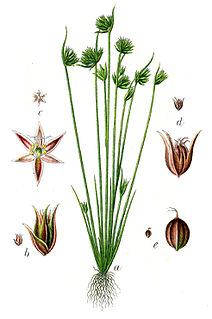
Juncus capitatus is a species of rush known by the common names dwarf rush and leafybract dwarf rush. It is native to Europe, Asia and North Africa. It is also an introduced species in parts of North America such as California and the Gulf Coast. It grows in moist areas, such as wet sand, vernal pools, and ditches.
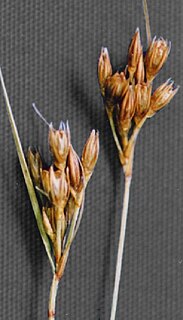
Juncus confusus is a species of rush known by the common name Colorado rush. It is native to western North America from British Columbia to northern California to Colorado, where it grows in coniferous forests and wet, grassy areas such as mountain meadows. It is a bunching rhizomatous perennial herb which grows to a maximum height between 30 and 50 centimeters. Its thready leaves grow from the base of the light green stems to about 15 centimeters long. The inflorescence atop the stem is an array of individual flowers and there is a long bract at the base which may be up to 8 centimeters in length. Each flower has long, pointed tepals with dark and light longitudinal stripes and membranous, translucent borders. There are six stamens. The fruit is a light to dark brown oval-shaped or rounded capsule.
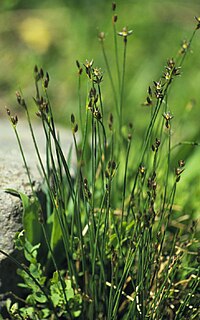
Juncus drummondii is a species of rush known by the common name Drummond's rush. It is native to western North America from northern Canada and Alaska to New Mexico, where it grows in wet coniferous forest and alpine meadows and slopes. This is a perennial herb forming narrow, erect tufts to about 40 centimeters in maximum height. The leaves are basal and most have no real blades; instead they form a sheath around the stem a few centimeters long. The inflorescence is borne on the side of the stem toward the top. There is a long, cylindrical bract at the base which extends out past the flowers. Each flower is on a thin pedicel. The thick tepals are dark brown, sometimes with green striping and thin, transparent edges. There are six stamens with yellowish anthers, and red stigmas. The fruit is a capsule.

Juncus ensifolius is a species of rush known by the common names swordleaf rush, sword-leaved rush, and three-stamened rush. It is native to much of western North America from Alaska to central Mexico, and into eastern Canada. It is present in Japan and far eastern Russia, and it has been introduced to many other regions of the world, including Europe, New Zealand, Hawaii, and Australia. It is a plant of wet areas in many types of habitat. This is a rhizomatous perennial herb forming clumps of stems 20 to 60 centimeters tall. The flat but curving leaves are mostly located at the base of the stems and are variable in length. The inflorescence is an array of many rounded clusters of many flowers each. Each flower has a number of dark brown to black tepals a few millimeters long and usually three small stamens enclosed between them. The fruit is an oblong capsule with a small beak on the tip.
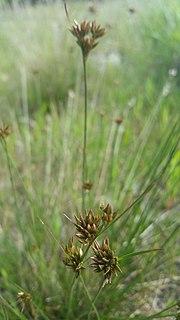
Juncus occidentalis is a species of rush known by the common name western rush. It is native to the western United States, where it grows in wet areas in many types of habitat. This is a bunching perennial herb with thin, stiff stems reaching maximum heights between 30 and 60 centimeters. The wispy leaves grow from the base of the stem and may approach half the stem's length. The inflorescence holds loose bundles of individual flowers and there is usually one long, leaflike bract extending far past the flowers. Each flower has green-striped brownish to reddish tepals each several millimeters long, and six stamens with small anthers. The fruit is a brown capsule which grows encased within the tepals.

Juncus patens is a species of rush, known by the common names spreading rush and California grey rush.
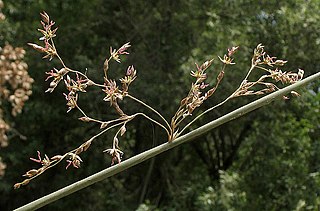
Juncus textilis is a species of rush known by the common name basket rush. It is endemic to California, where it grows along the coast and in the coastal mountain ranges of the southern half of the state.
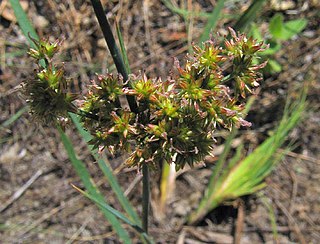
Juncus xiphioides is a species of rush known by the common name irisleaf rush.
Juncus bryoides is a species of rush known by the common names moss rush and mosslike dwarf rush. It is native to western North America from Oregon to Baja California, where it grows in many types of wet, sandy habitat. It is a very tiny annual herb producing erect, hair-thin stems no more than about 2 centimeters tall. Atop the stem is one flower made up of a few reddish segments 1 to 3 millimeters long which curve around the developing fruit.

Juncus howellii is a species of rush known by the common name Howell's rush. It is native to the northwestern United States, where it grows in moist mountain meadows. This is a perennial herb growing from a thick rhizome and producing stems up to about 60 centimeters tall. The inflorescence is a series of clusters of small flowers, each flower with brown or green pointed segments a few millimeters long.
Juncus kelloggii is a species of rush known by the common name Kellogg's dwarf rush.

Juncus longistylis is a species of rush known by the common name longstyle rush. It is native to much of North America, including most of the United States and the southern Canadian provinces. It grows in moist terrestrial habitat, such as mountain meadows. It is a rhizomatous perennial herb forming clumps of slender stems up to about 60 centimeters tall. The inflorescence is made up of one to nine clusters of a few tiny flowers each. The flower is made up of several segments which are green with translucent margins.

Juncus macrophyllus is a species of rush known by the common name longleaf rush.
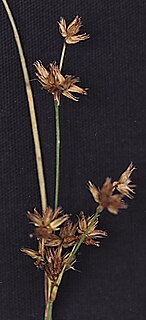
Juncus nodosus is a species of rush known by the common name knotted rush. It is native to much of North America from northern Canada to central Mexico, where it grows in wet places from freshwater to salt marsh habitat. This is a rhizomatous perennial herb producing slender, smooth stems up to about 60 centimeters tall. The inflorescence is a series of spherical clusters of flowers. Each flower has green or brown pointed segments each a few millimeters long and tapering to a point.

Juncus orthophyllus is a species of rush known by the common name straightleaf rush native to western North America from British Columbia to California and Nevada, where it grows in moist spots in mountain habitat, such as meadows.
Juncus triformis is an uncommon species of rush known by the common names Yosemite dwarf rush and long-styled dwarf rush.
Juncus digitatus is a rare species of rush known by the common name finger rush. It is endemic to Shasta County, California, where it is known from only two occurrences near Shingletown. It occurs in spring-moist habitat such as vernal pools in sunny locations in the foothills of the southernmost Cascade Range. The plant was first collected in 1991 and described to science as a new species in 2008.

Juncus phaeocephalus, the brown-headed rush, is native mostly along the coast of California, north to Oregon and Washington. It grows in moist seeps and shallow wet soil.
















